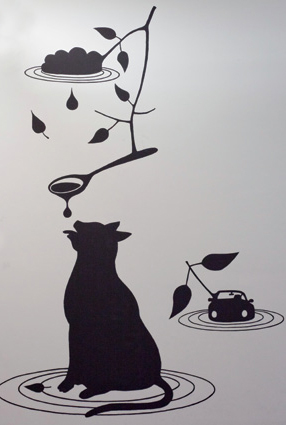YVES NETZHAMMER: NATURE, FEAR, ENTITY
| October 19, 2011 | Post In LEAP 10

I went to see this new installation by Yves Netzhammer with a lawyer friend. At one point he turned to me and asked, “What’s this guy actually trying to say?” This question has been asked numerous times in art galleries, and will surely continue to be. Always likely to draw a slightly patronizing smile, its subsequent evasion is perhaps an indication of the increasing arrogance of the contemporary art world. Though the essential outcome is such that the person asking cannot expect an answer, whilst the person asked has long since mastered that wry, face-saving smile.
However, I chose to answer his question: “It’s essentially about universal psychological experiences of various facets of contemporary life… this artist has chosen to portray those experiences using the human body, and to highlight a tension between body and space.” By this, I meant: if the audience is looking for a narrative i.e. “What’s it saying?” then Netzhammer’s work is fundamentally unconcerned with narrative. The visual forms he constantly strives to control hint at their own environment, as well as at psychological oppression; sound (featured in the installation) too in its physicality bolsters the very feeling of space, occasionally alludes to something emotive, but never gives too much away.
Right now, Netzhammer’s work seems to be in a state of change, a crucial period perhaps being the weeks leading up this solo exhibition at Minsheng. In 2008, for what seemed to be a routine open-studio event, Netzhammer presented an introductory slide-show on a huge projector. An oversized laptop sat atop an undersized table showing a constant stream of animations, whilst a collection of oddly sized folders had been stuck together to form a rudimentary easel on which were precariously attached some drawings. This abundance of material elements transformed the studio into a totally immersive sensory experience; the success of his 2007 presentation at the Swiss Pavilion of the Venice Biennale was equally about to his ability to transform. For that event he covered the entire space with television monitors, showing constant animations.
Leading up to his Minsheng exhibition, such rigorous experimentation with the potential relationships between space and material— usually painting and/or animation— has developed into an innovative formal practice. His original plan for this show, already finalized, was ditched on arrival: the artist began searching for materials, producing new work (animation, sound, installation), constantly editing, updating, renewing, until the opening day arrived and the work was finally declared “finished.” Perhaps it was the urban saturation of Shanghai, the intensity of its daily life, that so aroused this Swiss artist, his obsessive searches not limited to industrial materials, hardware stores, stationery shops. He traveled all over the city; somewhere he found a discarded white porcelain wash basin, rusty and broken, took it back to the gallery and turned it into a projection screen. The finished installation was quite theatrical, like a narrative acted out by objects and materials; compared to Netzhammer’s previous work, the role of animation has been downplayed.
At least two things are worth serious consideration. First is the tension between materials and environment, a focus that has long been important to this artist’s practice. Second is how, this outpouring of creative energy will ultimately be absorbed into the artist’s own creative logic. Such spontaneous productivity also raises new issues for both gallery and audience: for the gallery, it entails complication; for the audience, it signifies the need for a different approach, a kind of “spontaneous interpretation.” Finally, a question that’s been burning: what kind of mark does this way of working leave on the otherwise clear creative trajectory of such an artist? Does it signify a new beginning for Yves Netzhammer? Aimee Lin (Translated by Dominik Salter Dvorak)

